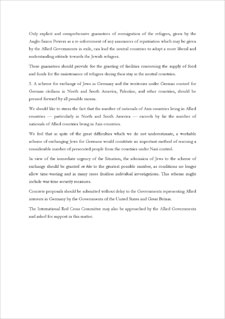Aide-Mémoire for Jewish Refugees
Among other things, Visser ’t Hooft was also involved in refugee work in Geneva. He had been well informed about the Holocaust in Europe since 1941. Looking back, he described his role thusly:
In Geneva, I worked closely together with the Dutch “Jewish Coordination Committee”, which had been established by M. H. Gans [...] I assumed the function of the liaison between the Jewish Coordination Committee and the Dutch government in London […]
In order to save as many Jews as possible, the Committee was forced to use unorthodox methods. Thus, it bought up passports of various Latin American countries and sent them to Jews in Dutch internment camps. Astonishingly, this method had at least partial success. It was therefore a blow when M. H.Gans learned in January 1944 that several governments were refusing to recognize the passes as valid […]
In the early hours of the next morning, he came to me together with the elderly chief rabbi of Zurich, Dr. Lewenstein. We decided that Dr. Lewenstein and I would approach Queen Wilhelmina in a telegram from both of us. This time, the response was prompt. Dutch diplomats’ démarches secured acknowledgement of the validity of the passports concerned. (W. A. Visser ’t Hooft, Die Welt, p. 206f.).
Together with Adolf Freudenberg (1894–1977) and Gerhart Riegner (1911–2001), Secretary General of the World Jewish Congress, Visser ’t Hooft drafted a memorandum in early 1943 for, among others, the League of Nations’ High Commissioner for Refugees, which was intended to empower neutral countries in particular to receive Jewish refugees. This appeal met with very little response internationally – except from Bishop Bell.
Source / title
- © Archiv des Ökumenischen Rates der Kirchen Genf; quoted from Johan E. Snoek, The Grey Book, p. 275-277


